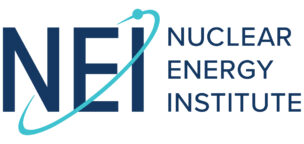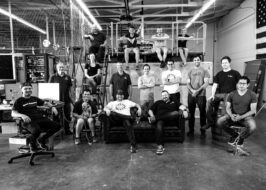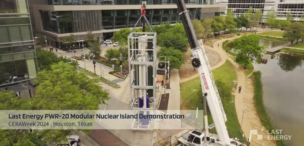Fusion startups are racing to develop the holy grail of clean energy: near-limitless power that’s free of carbon emissions and radioactive waste. According to US President of Tokamak Energy Michael Ginsberg, they can’t do it alone.
Ginsberg has spent more than a decade working in clean energy technologies. He’s tackled solar and wind, worked in batteries and hydrogen, and now he’s taking his emerging energy expertise to the next level in fusion. Ginsberg became president of Tokamak Energy’s US operations in December 2023.
Ginsberg chatted with Ignition about where fusion fits into the landscape of clean power, the need for cross-collaboration and partnerships in this stage of the industry, and the development of a sustainable business model in the years before fusion reactor deployment.
This interview has been edited for length and clarity.
Ignition: What made you want to make the switch to fusion?
Ginsberg: I think that fusion energy has the potential to be really transformational. I spent 15 years on a whole host of other technologies, from solar and wind to batteries and hydrogen. I think fusion is one of those solutions that can really not only mitigate our climate change crisis, but also take us into the future in terms of advancing our society, providing abundant energy, and taking us into space. So I was really excited about the fact that we’re so close to commercialization.
Commercialization is an interesting thing to bring up, since I think the perception of fusion in particular is that it’s a little bit further out. How are you thinking about the opportunity for fusion to commercialize in the near future?
I came from a startup before this where I was buying equipment off the shelf, essentially, even though it was a new application. In this case, I see us as having established the scientific principles for fusion, we know it can work…I would say that it’s always more of a function of investment that goes into technology, in terms of how fast we get there. But I think that there’s really a good amount of momentum globally. And I’m really hopeful that the US starts to accelerate its interest in this.
In the time that you’ve been working at Tokamak and in fusion, what do you find different about the fusion industry compared to other clean energy industries?
There’s still a really nice collaborative culture. With solar and hydrogen today, it’s very, very competitive. Fusion has traditionally been an area where there’s a lot of research and development, and you see a lot of that transfer of the university to the private sector. There’s a lot of willingness to collaborate on research, which is really nice.
I think we’re still at a period of time where we’re down-selecting or filtering out the best, most promising technologies—for instance, this Department of Energy program that we’re a part of has selected eight different distinct technologies. So we’re still in that phase of figuring out what is the most promising one.
This era of collaboration within fusion is interesting, because I’ve heard that it’s different between the fusion and fission industries. Do you see a conflict between them?
The fission community is a lot more established. We’re talking about existing reactors that have been in the ground for a long time. Even small modular reactors are starting to undergo permitting. I would say there’s also a lot more hopefulness and promise when it comes to fusion—maybe it’s a little bit of my bias, but I think because of the benefits of the technology being cleaner and not having the radioactive issues that you do with fission, there’s a lot more optimism that this industry can be a real clean solution.
I’m curious about how you think about the future and developing a sustainable business model when you’re working on the long timescale to commercialization—for Tokamak, we’re looking at the 2030s.
We have a strategy of achieving some near-term revenue before the commercial fusion plants that come about in the 2030s. With that we are a world leader in our high-temperature superconducting magnets. We are now leveraging and commercializing those magnets in the near term—in fact, in 2023, we had our first revenue with those, and in 2024, we’ve got millions of pounds of revenue forecasted, which is really going to increase through the mid to late 2020s.
So the revenue that’s coming from this business is also funneling into fusion reactor development. What share of the total financing for fusion reactor development do you think will come from revenue vs. raised capital?
We’re now transitioning to a company that doesn’t do successive raises in the future. We do see this revenue to sustain both the magnets company as well as fusion development of actual pilot plants. But we’re under no false conception that we won’t need additional money to build a real fusion plant because that’s a big ticket. We are very much a kind of company that believes in public-private partnership, which is when the private sector brings in a percentage, the federal government—there’s gonna be a contribution from multiple parties. And so we want to make ourselves a more robust company by being sustainable and generating revenue so that we can cover ourselves and then we don’t have to keep coming back to the market to ask for it.
What have you been focusing on in your first few months as president of the US branch?
The US entity has actually been around for four years, but now as a part of the Department of Energy program, we’re really expanding here into the US. Our focus is all about taking the technology that has been developed in the UK and expanding and growing it in the US, not only with the construction of new facilities as part of the DOE program, but also potentially magnet facilities for other customers, whether that be the medical sector or defense sector.
My second focus has been raising our visibility with key stakeholders—the DOE and Congress and the general public. My role here is to make us a lot more American and find an identity for us here. So I think we have a wonderful relationship with the National Labs already that we’ve had for about 10 years. So I’m leaning into that and building on that.
What opportunities are you seeing to collaborate with US programs?
We have been part of the National Lab INFUSE program for a long time. Those are cost-share grants that are given from the DOE to the labs, and then with a private company contribution. We are developing a lot of our technology in those National Labs in the US. We intend to increase that relationship. Then, through the DOE milestone program, we are currently finalizing contracts with the labs to further develop an actual physical plant.
In addition to that, we are looking at places to build the plants in the US. So I’m managing a nationwide search for the right state, the right locality for a future fusion plant.
What goes into that decision-making process of selecting a site?
Essentially, we look at the level of interest from the state, which is evidenced through potential support in terms of grants or tax incentives. We also look at community support, or whether or not there’s potential resistance or opposition. We want to work very closely with the community here. A big part of it is also finding out from a commercial perspective where our customers will be, and we know who would like to use fusion. It’s a very complex equation.
Any frontrunners right now?
We have a really great relationship with the Princeton Plasma Physics Laboratory, so we have been looking in New Jersey. We have a good relationship with a number of universities throughout the country. So we’ve started there. So UIUC, we work closely with General Atomics in California and Oak Ridge National Lab in Tennessee. So you’ve probably heard the public announcement from Type One Energy that they are building their facility in Tennessee. So there’s a lot of state support at the government level.
Are you seeing any opportunities right now for collaboration on the commercial side of things with other companies in the space?
A big part of my role is to identify partnerships as part of the DOE program. So I’m talking to a whole host of other types of companies, from users of industrial heat to companies that have an increased demand for energy for computing. We’re looking to decarbonize heavy industry.
How do you anticipate the US operations expanding in the coming year?
I see us as being the primary market for our magnet technology in the world, outside of the UK. So there’s going to be a lot of business development, but potentially, I could see us constructing a magnet facility here in the US separately from the fusion pilot plants—though the development of our future pilot plants is core to everything we do here. But beyond that, we need to build up a technical team here in the US.
What are the hallmarks of a successful nuclear company?
I think a successful fusion company is one that embraces a model of collaboration. What I mean by that is understanding that every company has its own specialization. And so we need to complement the others and leverage those partnerships because it is a hard nut to crack. I know a lot of VCs are saying everything should be vertically integrated from day one. I don’t know how realistic that is right now. A successful nuclear fusion company is one that really leverages its core skill set, and then relies on others for some of the subsystem expertise that doesn’t happen. It’s sort of similar to the semiconductor industry, figuring out a way to make your products essential to what everyone else is doing.
What role do you think nuclear power generation plays in mitigating the climate crisis?
It’s interesting because I came from solar and batteries and hydrogen and I was always a little tepid about nuclear myself. I was thinking more about the fission side. Fusion is a very important tool for overcoming some of the major issues that we have in interconnecting variable renewable energy, i.e., solar and wind and batteries into the grid. It is a way of delivering baseload clean power, just so long as we can ensure that it’s developed responsibly, without serious, long-term environmental issues, which is something we obviously learned from the fission industry. We have to very responsibly develop this technology. I’ve been in the round in this climate crisis for most of my professional life, and I think that we need a first wave of alternative energy technologies, and then a second wave that will really allow us to deeply decarbonize our industry, and especially in those heavy industries. It’s very hard to decarbonize those and that’s what excited me about hydrogen at first, and I also see that potential for fusion.
What do you think the landscape of power generation will look like in 2050?
I think it’s going to be somewhat diverse by country and by region. I do think the tipping point has been reached with solar, and I think we’re gonna see a lot more gigawatts of utility scale solar and wind. And I do think that fusion will be especially valuable in emerging economies, and in places where reliability is critical. So I could see a fusion system as part of an energy security strategy for a country like Ukraine, for instance. If we had fusion today, Ukraine would be much better off. And I do believe that by 2050 we’ll be off of fossil fuel.
Lead Reporter of Ignition





